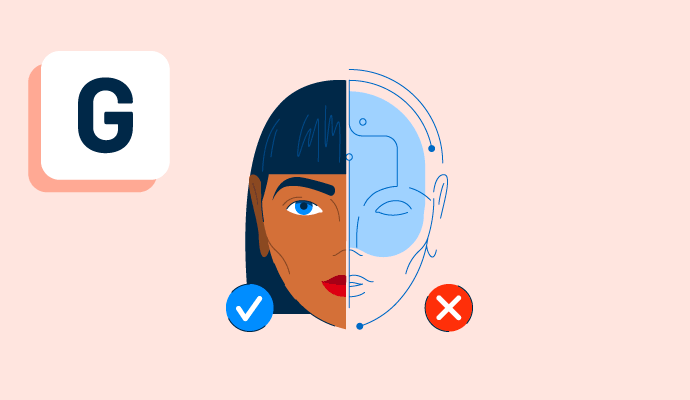What is GAN?
Generative adversarial networks (GANs) were first developed and introduced by Ian J. Goodfellow in 2014. GAN is a machine learning technique that helps generate synthetic media that describes video, image, voice, or text, partially or fully generated by artificial intelligence. Synthetic media software helps take input from the users and produce media as an output which can then be used for training, entertainment, and much more.
GANs are an approach to generative modeling using deep learning methods to make their predictions more accurate. They mainly consist of two parts:
- Generator: Generates plausible data, which become negative training examples for the discriminator.
- Discriminator: Distinguishes between the generator's fake and real data and penalizes the generator for producing implausible results.
The generator creates fake content while the discriminator detects whether this content is real or fake. They work on improving together and thus become better at detecting fakes. The back-and-forth process continues until the generator produces a highly realistic synthetic content.
How do GANs work?
GANs follow a simple, straightforward way of working. They are divided into three categories:
- Generative: Describes how data is generated based on a probabilistic model
- Adversarial: Model trained in an adversarial setting
- Networks: Used as artificial intelligence (AI) algorithms for training purposes
The first step to establishing a GAN is identifying the desired end output and gathering an initial training dataset based on said parameters. The data is then randomized and input into the generator until basic accuracy in producing output is achieved.
Next, the sample content is fed to the discriminator, and the actual data point is related to the original concept. Once the generator and the discriminator models have processed this data, a process of optimization through back propagation takes place. The discriminator filters the information and returns probabilities between 0 and 1, wherein 0 corresponds to real images and 0 to fake images. The process repeats until the GAN achieves its desired outcome.
What are GANs used for?
GANs are becoming highly popular due to their ability to understand and recreate visual content with great attention to detail and remarkable accuracy. They prove beneficial for various tasks, including but not limited to data augmentation, picture synthesis, anomaly detection, and more.
Some of the typical generative adversarial networks applications are:
- Diagnosing health conditions
- Converting black and white images to color
- Creating photorealistic depictions of product prototypes
- Generating human faces
- Developing fashion designs
- Developing video game characters
- Generating realistic 3D images
- Creating realistic animal images
Types of GANs
Generative adversarial networks have multiple purposes. The different types of GANs are:
-
Vanilla GAN: Vanilla GAN is the simplest of all GANs and algorithms. It tries to optimize mathematical equations with stochastic gradient descent, an algorithm that helps machine learning applications choose the best fit between predicted and actual outputs. It consists of both the generator and discriminator and the generated image classification is done as straightforward multi-layer perceptrons. The discriminator determines whether the input belongs to the class, and the generator collects data.
- Conditional GAN: Conditional GAN enables the conditioning of the network with new information by applying class labels. During the GAN training, the network receives images with the actual label, i.e., “tulip” and “sunflower,” helping it learn how to distinguish between them.
- Deep convolutional GAN: With the help of deep convolutional neural networks, this GAN helps generate high-resolution images that can be easily differentiated. It is a technique to draw important information from generated data, allowing the network to absorb the required details quickly.
- CycleGAN: A common GAN architecture used to learn how to transform between images of various styles, CycleGAN helps teach a network how to alter an image from winter to summer or from one animal to another. It can also alter human faces that fit into different age groups.
- StyleGAN: It produces realistic, high-quality photos of faces that users can modify to alter their appearance.
- Super-resolution GAN: A low-resolution image can be changed into a highly detailed image while increasing the resolution of the image and filling in blurry spots.
Advantages of GANs
GANs come with a ton of advantages. Some of the common ones are listed below.
- Synthetic data generation: GANs generate new, synthetic media that resembles data distribution and can be helpful for anomaly detection, creative applications, and data augmentation.
- High-quality results: GANs produce high-quality results for various applications such as music synthesis, video synthesis, image synthesis, and more.
- Unsupervised machine learning: GANs have the potential to learn from unlabeled data, thus making them suitable for unsupervised machine learning tasks where labeled data may be challenging to obtain.
- Versatility: GANs can be applied to a wide range of applications.
CNN vs. RNN vs. GAN
Convolution neural networks (CNN) are used for image and video recognition tasks, particularly to identify image patterns and features. Recurrent neural networks (RNN) are well-suited for sequential data such as natural language or time series data. They have a memory component that allows sequential processing and helps maintain context.
GANs are used for generative tasks such as creating new videos, text, or audio and distinguishing between real and fake data. In conclusion, CNN is useful for image processing, RNN for sequential data processing, and GAN for generative tasks.
Look at other AI-generative software that helps businesses in various industries that require AI-generated content for their work.

Tanuja Bahirat
Tanuja Bahirat is a content marketing specialist at G2. She has over three years of work experience in the content marketing space and has previously worked with the ed-tech sector. She specializes in the IT security persona, writing on topics such as DDoS protection, DNS security, and IoT security solutions to provide meaningful information to readers. Outside work, she can be found cafe hopping or exploring ways to work on health and fitness. Connect with her on LinkedIn.



















